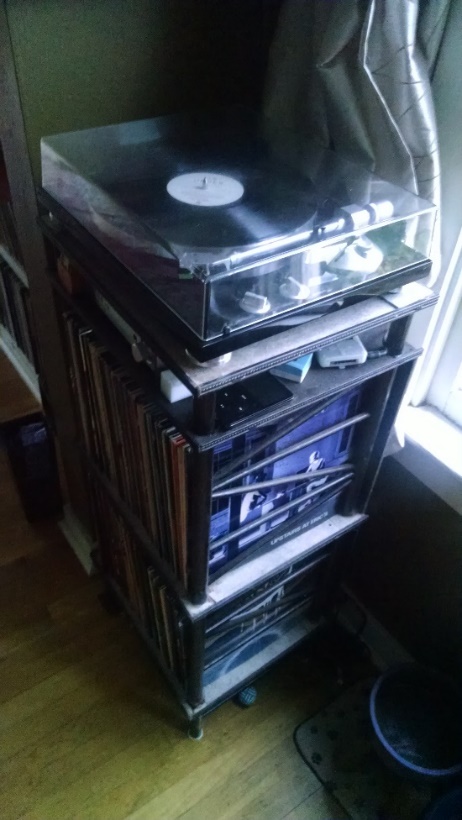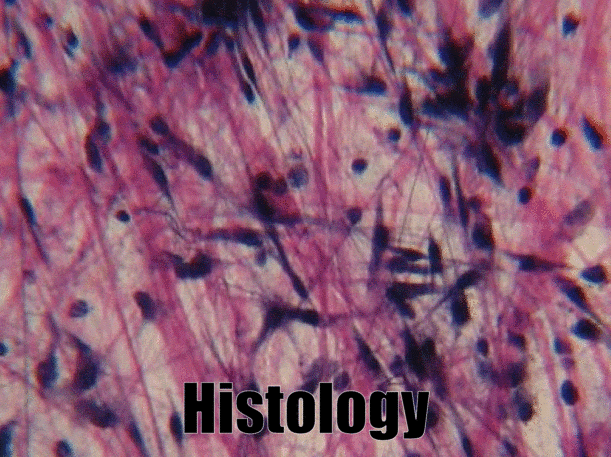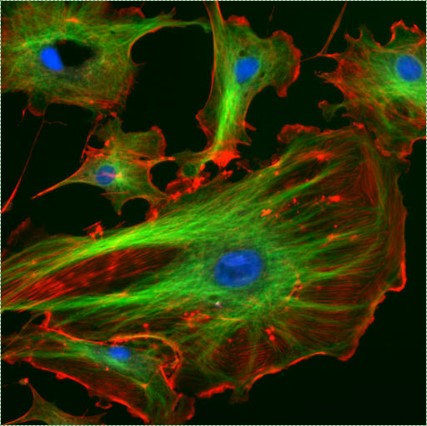Preface

Why study histology and embryology?
This home-built stand for a record player is going to serve as a metaphor. Measurements were made to ensure there would be enough space for records. It is built out of wooden dowels, and used some floor tiles to create a smooth surface. Why use those materials? Actually, those building materials were re-used, they were left over from previous projects. Sure, a trip to the hardware store could have yielded more appropriate materials, but would the hassle have been worth it? No. This is why you should study embryology, many instructions and materials are re-used during human development. As a result, some organs or tissues have a shape that matches their function, others do not. For example, why is enamel made by epithelial cells, when it looks like bone tissue? Why can a piece of pig tissue be used to surgically repair gingival tissue? What is the function of the philtrum? These are questions that can be better answered by studying where things come from (embryology) rather than studying what they look like (anatomy). Imagine not knowing that flies develop from maggots, you might believe in spontaneous generation after observing the appearance of maggots on rotting food.
Then why study histology? The answer to that is simple: embryos are tiny, you need a microscope to see what is going on. But with a basic understanding of oral histology you will understand why a pocket depth over 3 mm is considered unhealthy. You can conceptualize what makes the linea alba appear white in some patients. You can explain what causes perikymata. You are on your own, however, on how to pronounce perikymata.
Because it is no possible to take tissue samples from human embryos, we occasionally look at the development of other species. These include rats, frogs (in space!), sea urchins and tunicate worms. We can learn a lot from distant relatives because humans re-use developmental processes for different purposes. Hopefully, you will gain an appreciation for the link between evolution and development. What can a headless, toothless sea creature teach you about dental hygiene?
Autho bio:
Laird C. Sheldahl, Ph.D.
Open Educational Resources: OER Commons
ORCID: https://orcid.org/0000-0002-3298-5436
I am the lead author and illustrator of this textbook. I have a Ph.D. in physiology and pharmacology. I currently teach at Mt. Hood Community College in Gresham, Oregon. My Ph.D. thesis studied a morphogen (Wnt) involved in the formation of the head and neural crest cells. This morphogen is re-used during development of the teeth. To study this process in frogs (their embryos are not inside uteruses, which makes them easier to study) I did a lot of microscopy. I do not have a background in dental hygiene, and am therefore very happy to have expert collaborators.
Reviewers
Raye Ann Yapp, RDH, MS
Raye Ann Yapp is a retired full time dental hygiene instructor and program director at Mt. Hood Community College in Gresham, Oregon. Currently, she teaches part time in periodontics and second year clinical courses. Prior to her teaching experience, she practiced dental hygiene for a periodontal specialist for twenty-two years. In addition to her A.S. Degree in Dental Hygiene from MHCC, she holds a B.A. Degree in Organizational Communication from Marylhurst University and an M.S. Degree in Education from Portland State University. Her favorite people are her dental hygiene students and fellow faculty, and when not studying material for her courses, she loves to cook, quilt, and walk with her husband and Edgar (the Pug).
Babiy, Ilya, RDH, MS, EPP
Ilya Babiy is a full-time dental hygiene instructor, first year clinical coordinator, and radiology lead at Mt. Hood Community College. He also serves seniors and people with special needs with his mobile dental hygiene business, On-Site Oral Health Care, which he started in 2014. Ilya earned his A.S. in Dental Hygiene at MHCC, B.S. in Dental Hygiene at Oregon Institute of Technology, and M.S. in Education from Portland State. He enjoys inspiring students to fulfill their dreams and make a difference in our world. Ilya and his wife have three children. They love to travel, entertain family and friends, and explore the great outdoors.
Editor
Amen Mohammed
My name is Amen Mohammed. I am originally from Ethiopia. 🇪🇹. I am a mom and a wife. My career was journalism when I was back home. Here in USA I do any work to survive. I have worked in many places. I worked at The Home Depot, K-mart, Tri-met, Mentor and Uber driver and Lyft driver. But I wasn’t happy working as a laborer, and I couldn’t find the job love with my experience, that is what made to go back to school. I am at Portland State University right now. I want to be medical student and want to be a Gynecologist. I like cooking sometimes, reading history books, walking, and running 🏃♀️ is what I like to do when I have time. I have preteen boy 👦 who makes me busy next to classes. He love basketball 🏀 and football 🏈.
Choose your own adventure
Some links in the book take you to an external website, such as Wikipedia. These links should be a monospace font, such as this: external link. We don’t have control over how they appear on your eReader. External links are for further reading or watching if you are interested, but are not required to understand the material we present. If your eReader or computer is not connected to the internet, these links will not work.
Definitions, such as morphogen, allow you to click on a word and read a short description. Their behavior may be missing in some eReaders. Definitions appear once per paragraph, and the description is limited to human biology. We do at times cover the development of sea urchins, mice, fish and frogs (in space, no less). Humans share aspects with all of these critters, for reasons that should become clear.
For important words and phrases defined in another chapter, such as differentiation←, you can read the definition by clicking on the word, or follow the ← icon to jump forward or back to the section where it is described in detail. Use the “back” button on your web browser to return to your spot. Some eReaders may not have a way for you to return to your spot easily (try testing it now). Unlike external links, definitions should work regardless of your internet connection, assuming your eReader supports them. We encourage you to use ← icons to pick your own non-linear path through this textbook.
The basic format of each chapter is as follows:
| Chapter outline | Content: |
|---|---|
| Overview | Provides a road-map for what is covered, and why. |
| Physiology | Where histology and embryology are covered. |
| Clinical significance | Why histology or embryology is relevant to clinical practice. |

Animated images
The image in Fig. 0.2 is an animated .gif file, it should be cycling through a series of changes. The authors wish to take advantage of things that can be done in an eBook, but not a print book. Unfortunately, animated gifs do no work in pdfs or on the Amazon Kindle (.mobi format). They cannot be slowed down or paused.

Fluorescent cells” by NIH image is in the Public Domain CC0
Images that we have not created have their sources listed in the figure legend, such as Fig. 0.3. This follows the Creative Commons rules for using other people’s work the way they have asked. This may be of use to teachers, but students can ignore this information. American audiences take note, when we use images created by people who write in the Queen’s English, there will be spelling differences and tooth numbering differences in the image credits.

If you see something that looks like Fig. X, an image has failed to load. Try hitting the reload button if you are in a web browser (often located up in the menu bar, it probably looks like a circular arrow).
Course objectives
| Course objective | Textbook chapter(s) |
|---|---|
| 1. Identify core concepts of cell biology and general histology related to the face and oral cavity | 1,2 |
| 2. Demonstrate an understanding of the role of epithelial tissues, underlying connective tissues and neural crest cells in the face and oral cavity | 3,4,5 |
| 3. Identify the basic patterns of early human developmental biology related to formation of the face and oral cavity | 6,7 |
| 4. Describe the major steps of amelogenesis and enamel structure | 8, 9 |
| 5. Describe the major steps of odontogenesis and formation of the dentin-pulp complex | 8, 10 |
| 6. Describe the major steps of development of tooth roots and the periodontium | 8, 10, 11 |
| 7. Identify mesenchymal-epithelial relationships in tooth development and tooth eruption. | 8, 9, 10, 11 |
Copyright information

Histology and Embryology for Dental Hygiene is published under the Creative Commons Attribution-NonCommercial-ShareAlike license. This license states that:
You are free:
- to Share — to copy, distribute and transmit the work
- to Remix — to adapt, revise, and improve the work
Under the following conditions:
- Attribution — You must attribute the work in the manner specified by the author or licensor (but not in any way that suggests that they endorse you or your use of the work).
- Noncommercial — You may not use this work for commercial purposes.
- Share Alike — If you alter, transform, or build upon this work, you may distribute the resulting work only under the same or similar license to this one.
When attributing derivatives of Histology and Embryology for Dental Hygiene, please use the following attribution:
Sheldahl, Laird C. Histology and Embryology for Dental Hygiene. Retrieved from https://openoregon.pressbooks.pub/histologyandembryology/ . ISBN: 978-0-578-76350-7 Licensed under a Creative Commons Attribution NonCommercial ShareAlike (BY-NC-SA) license.
navigation * Chapter 1 >
Chapter review questions
A substance whose non-uniform distribution governs the pattern of tissue development and pattern formation.
When one cell begins to look different from another. This process involves limiting cell fate by altering gene transcription to become more specialized.

